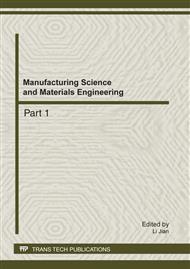[1]
X.T. Xia, T.M. Lv, and F.N. Meng, Gray chaos evaluation model for prediction of rolling bearing friction torque, Journal of Testing and Evaluation, vol. 38, no. 3, 2010, pp.291-300.
Google Scholar
[2]
X.T. Xia and Z.Y. Wang, Grey relation between nonlinear characteristic and dynamic uncertainty of rolling bearing friction torque, Chinese Journal of Mechanical Engineering, vol. 22, no. 2, 2009, pp.244-249.
DOI: 10.3901/cjme.2009.02.244
Google Scholar
[3]
X.T. Xia, T.M. Lv, and F.N. Meng, Chaotic characteristic and nonlinear dynamic performance of rolling bearing friction torque, Applied Mechanics and Materials, vols. 26-28, 2010, pp.88-92.
DOI: 10.4028/www.scientific.net/amm.26-28.88
Google Scholar
[4]
Michael Flouros, Correlations for heat generation and outer ring temperature of high speed and highly loaded ball bearings in an aero-engine, Aerospace Science and Technology, vol. 10, no. 7, 2006, pp.611-617.
DOI: 10.1016/j.ast.2006.08.002
Google Scholar
[5]
S. Sochting, I. Sherrington and S. D. Lewis, et al., An evaluation of the effect of simulated launch vibration on the friction performance and lubrication of ball bearings for space applications, Wear, vol. 260, 2006, pp.1190-1202.
DOI: 10.1016/j.wear.2005.07.012
Google Scholar
[6]
A. Vanhulsel, F. Velasco, and R. Jacobs, et al., DLC solid lubricant coatings on ball bearings for space applications, Tribology International, vol. 40, no. 7, 2007, pp.1186-1194.
DOI: 10.1016/j.triboint.2006.12.005
Google Scholar
[7]
C. Nataraj and S.P. Harsha. The effect of bearing cage run-out on the nonlinear dynamics of a rotating shaft, " Communications in Nonlinear Science and Numerical Simulation, vol. 13, no. 4, 2008, p.822–838.
DOI: 10.1016/j.cnsns.2006.07.010
Google Scholar
[8]
Y.D. Zhang and L.N. Wu, Improved immune algorithm for image restoration, Optics and Precision Engineering, vol. 17, no. 2, 2009, pp.417-425 (in Chinese).
Google Scholar
[9]
J. Li,Y. Feng and X.Q. Yang, Invertible chaotic three-dimensional map based Image encryption approach and its optimized algorithm, Optics and Precision Engineering, vol. 16, no. 9, 2008, pp.1738-1745 (in Chinese).
Google Scholar
[10]
X.T. Xia, X.Y. Chen, and Y.Z. Zhang, et al., Grey bootstrap method of evaluation of uncertainty in dynamic measurement, Measurement. vol. 41, no. 6, 2008, pp.687-696.
DOI: 10.1016/j.measurement.2007.10.008
Google Scholar
[11]
Lv Jinhu, Lu Junan, Chen Shihua, Analysis and application of chaos time series. Wuhan: Press of Wuhan University, 2002 (in Chinese).
Google Scholar
[12]
J.H. Lv and S. C Zhang, Application of adding-weight one-rank local-region method in electric power system short-term load forecast, Control Theory and Applications, vol. 19, no. 5, 2003, pp.767-770 (in Chinese).
Google Scholar
[13]
J. Zuo, H. Wang and Z.F. Zeng, An improved model of add-weighted one-rank local-region multi-steps forecasting, Statistics and Decision, no. 6, 2008, pp.33-34 (in Chinese).
Google Scholar
[14]
Q.F. Meng and Y.H. Peng, Improved adding weight first order local prediction method for chaotic time series, Computer Engineering and Applications, vol. 43, no. 35, 2007, pp.61-64 (in Chinese).
Google Scholar
[15]
L.Y. Cao, Practical method for determining the minimum embedding dimension of a scalar time series, Physica D, vol. 110, 1997, pp.43-50.
DOI: 10.1016/s0167-2789(97)00118-8
Google Scholar
[16]
H. Kantz and T. Shreiber, Nonlinear Time Series Analysis, Cambridge University Press, Cambridge, (1997).
Google Scholar
[17]
J.L. Deng, Introduction to grey system theory, The Journal of Grey System, vol. 1, no. 1, 1989, pp.1-24.
Google Scholar
[18]
X.T. Xia and T.M. Lv, Chaos prediction of rolling bearing friction torque, Applied Mechanics and Materials, vols. 26-28, 2010, pp.190-193.
DOI: 10.4028/www.scientific.net/amm.26-28.190
Google Scholar


